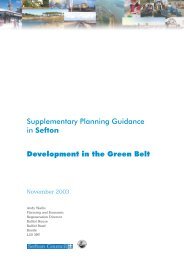The impact of sand extraction at Formby Point ... - Sefton Council
The impact of sand extraction at Formby Point ... - Sefton Council
The impact of sand extraction at Formby Point ... - Sefton Council
Create successful ePaper yourself
Turn your PDF publications into a flip-book with our unique Google optimized e-Paper software.
11<br />
on the <strong>Sefton</strong> Coast occur here but there is a lower-lying area, surrounded by Marramdomin<strong>at</strong>ed<br />
dune ridges, which is probably a relict <strong>of</strong> earlier <strong>sand</strong> removal. One blow-out<br />
in this area has eroded down to the w<strong>at</strong>er-table but not sufficiently, as yet, to form a<br />
slack. <strong>The</strong>re is a large area <strong>of</strong> prime N<strong>at</strong>terjack Toad habit<strong>at</strong> here but, unfortun<strong>at</strong>ely,<br />
nowhere for the cre<strong>at</strong>ure to breed. To the east <strong>of</strong> the highest ridge, is a dune valley which<br />
probably origin<strong>at</strong>ed from <strong>sand</strong>-winning. Clothed by Creeping Willow and Marram, it<br />
contains a scrape dug in 1987. Due to <strong>sand</strong>-accumul<strong>at</strong>ion, this is now rel<strong>at</strong>ively dry,<br />
containing only a little Marsh Pennywort (Hydrocotyle vulgaris) to indic<strong>at</strong>e the proximity<br />
<strong>of</strong> the w<strong>at</strong>er-table.<br />
Ravenmeols was surveyed in 1988/89 and 2003 for the <strong>Sefton</strong> Coast NVC. G<strong>at</strong>eley &<br />
Michell (2004) report th<strong>at</strong> fixed-dune communities became simplified with a gre<strong>at</strong>er<br />
proportion being recorded as SD7. Meanwhile, the areas <strong>of</strong> damp-slack decreased and<br />
the dry SD16 community, domin<strong>at</strong>ed by Creeping Willow, became more extensive.<br />
<strong>The</strong>ir findings support the observ<strong>at</strong>ions made during the current study.<br />
2.3.3. Cabin Hill<br />
Cabin Hill contains two extensive <strong>sand</strong>-winning areas, the most obvious one <strong>at</strong> the end <strong>of</strong><br />
Range Lane, in the ownership <strong>of</strong> <strong>Sefton</strong> <strong>Council</strong>, covers about 4.5ha and is well<br />
demarc<strong>at</strong>ed on three sides by cliffed dunes. <strong>The</strong> marks <strong>of</strong> heavy machinery are<br />
particularly well shown on the 1961 aerial photograph. <strong>The</strong> other, larger, site is less well<br />
defined both on aerial photographs and on the ground and covers part <strong>of</strong> the 28.4ha Cabin<br />
Hill N<strong>at</strong>ional N<strong>at</strong>ure Reserve leased in 1985 by the N<strong>at</strong>ure Conservancy <strong>Council</strong> (now<br />
N<strong>at</strong>ural England) and declared in 1991. <strong>The</strong> name <strong>of</strong> this area refers to the largest <strong>sand</strong>dune<br />
and landmark on this part <strong>of</strong> the coast which was completely removed, in places<br />
down to the w<strong>at</strong>er-table. This so weakened the coast protection function <strong>of</strong> the dune belt<br />
th<strong>at</strong> the then Mersey & Weaver River Authority constructed a flood defence barrier bank<br />
about 750m long in 1970/71, <strong>at</strong> gre<strong>at</strong> public expense. To build the bank, <strong>sand</strong> was<br />
excav<strong>at</strong>ed from a series <strong>of</strong> linear borrow-pits, cre<strong>at</strong>ing wetlands which, from about 1976<br />
to 1988 became the most important N<strong>at</strong>terjack Toad breeding site on the <strong>Sefton</strong> Coast,<br />
250 spawn strings being counted in spring 1978 (Smith 1978c). In the l<strong>at</strong>e 1970s, the















